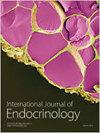Relationship between Serum Indoxyl Sulfate and Klotho Protein and Vascular Calcification in Patients with Chronic Kidney Disease Stages 3–5
IF 2.3
4区 医学
Q3 ENDOCRINOLOGY & METABOLISM
引用次数: 0
Abstract
Objective. This study aims to explore the relationships between serum indoxyl sulfate (IS) and Klotho protein levels with vascular calcification in patients with chronic kidney disease (CKD) stages 3–5. Methods. From December 2021 to January 2023, a total of 108 CKD patients in stages 3–5 were enrolled in this cross-sectional investigation. Demographic information and routine clinical biochemistry test results were gathered. Serum levels of IS and Klotho were quantified through enzyme-linked immunosorbent assays. Furthermore, multislice spiral computed tomography was employed to evaluate vascular calcification. The association between serum IS or Klotho levels and abdominal aorta calcification was assessed using univariate analysis and logistic regression analyses. Results. With the progression of CKD stages, serum creatinine, phosphorus, intact parathyroid hormone (iPTH), serum IS, and abdominal aortic calcification exhibited incremental trends, while serum calcium and Klotho protein levels showed a diminishing trend, with statistically significant differences (). Significant differences were observed in age, blood phosphorus, calcium, total parathyroid hormone, serum IS, and Klotho protein levels between patients with and without aortic calcification (). Logistic regression analysis demonstrated that advanced age, high IS level, and low Klotho protein level were independent risk factors for abdominal aortic calcification in CKD patients (). Conclusion. This study indicates elevated serum IS levels and decreased Klotho protein levels in CKD patients. High IS level and low Klotho level were independent risk factors for abdominal aortic calcification.慢性肾病 3-5 期患者血清硫酸羟吲哚酯和 Klotho 蛋白与血管钙化的关系
研究目的本研究旨在探讨慢性肾脏病(CKD)3-5 期患者血清硫酸吲哚酯(IS)和 Klotho 蛋白水平与血管钙化之间的关系。研究方法从 2021 年 12 月至 2023 年 1 月,共有 108 名 CKD 3-5 期患者参与了此次横断面调查。收集了人口统计学信息和常规临床生化检验结果。通过酶联免疫吸附试验对血清中的 IS 和 Klotho 水平进行量化。此外,还采用多层螺旋计算机断层扫描评估血管钙化情况。采用单变量分析和逻辑回归分析评估了血清IS或Klotho水平与腹主动脉钙化之间的关系。结果显示随着慢性肾脏病分期的进展,血清肌酐、磷、完整甲状旁腺激素(iPTH)、血清 IS 和腹主动脉钙化呈递增趋势,而血清钙和 Klotho 蛋白水平呈递减趋势,差异有统计学意义()。有主动脉钙化和无主动脉钙化的患者在年龄、血磷、血钙、甲状旁腺激素总量、血清IS和Klotho蛋白水平方面存在显著差异()。逻辑回归分析表明,高龄、高 IS 水平和低 Klotho 蛋白水平是慢性肾脏病患者腹主动脉钙化的独立风险因素()。结论。本研究表明,慢性肾脏病患者的血清 IS 水平升高,Klotho 蛋白水平降低。高IS水平和低Klotho水平是腹主动脉钙化的独立危险因素。
本文章由计算机程序翻译,如有差异,请以英文原文为准。
求助全文
约1分钟内获得全文
求助全文
来源期刊

International Journal of Endocrinology
ENDOCRINOLOGY & METABOLISM-
CiteScore
5.20
自引率
0.00%
发文量
147
审稿时长
1 months
期刊介绍:
International Journal of Endocrinology is a peer-reviewed, Open Access journal that provides a forum for scientists and clinicians working in basic and translational research. The journal publishes original research articles, review articles, and clinical studies that provide insights into the endocrine system and its associated diseases at a genomic, molecular, biochemical and cellular level.
 求助内容:
求助内容: 应助结果提醒方式:
应助结果提醒方式:


